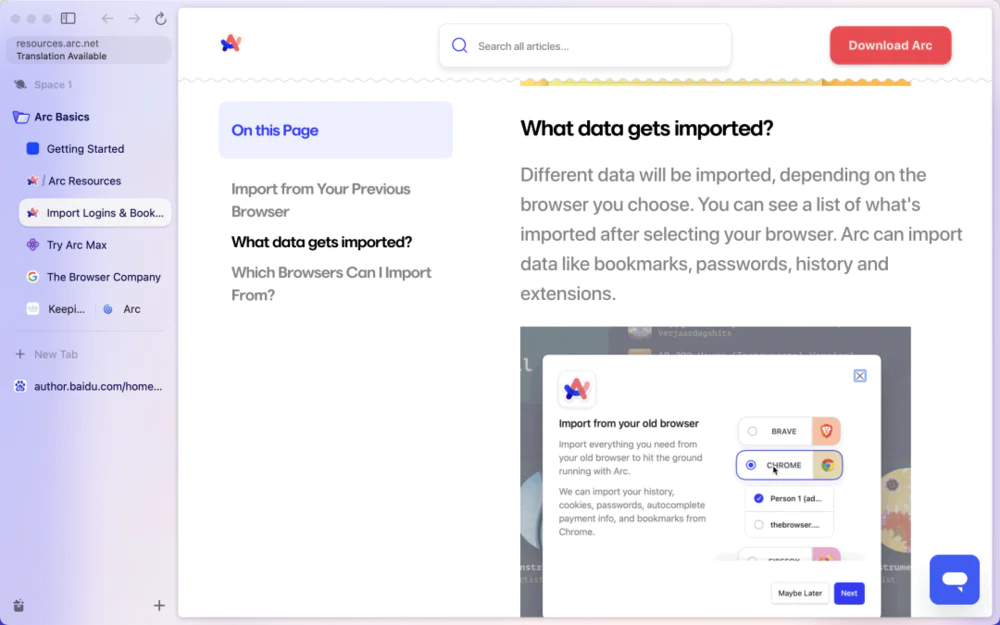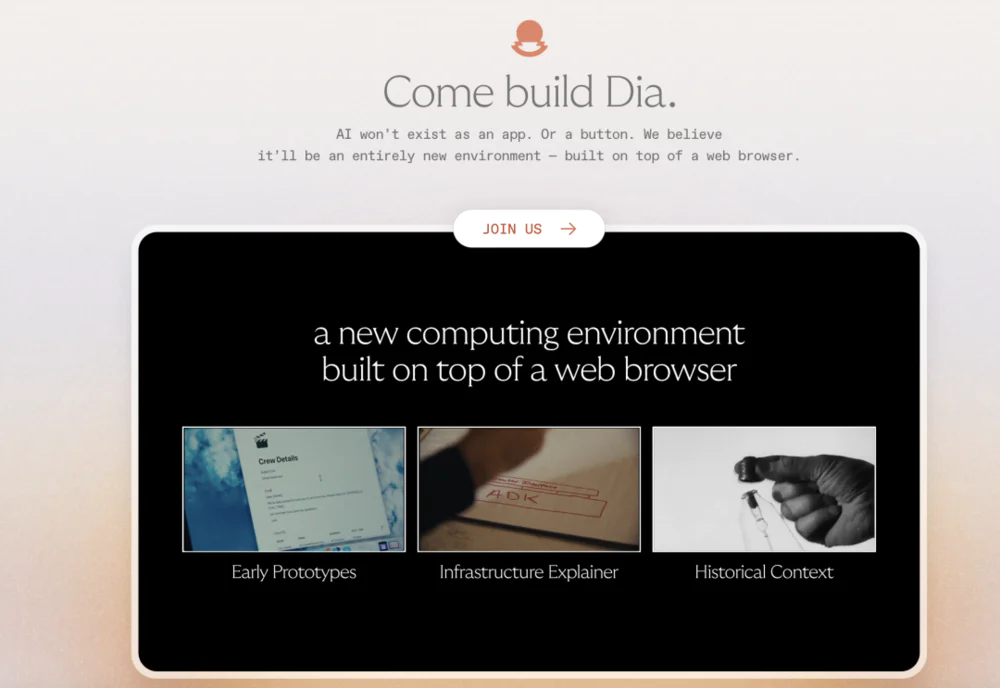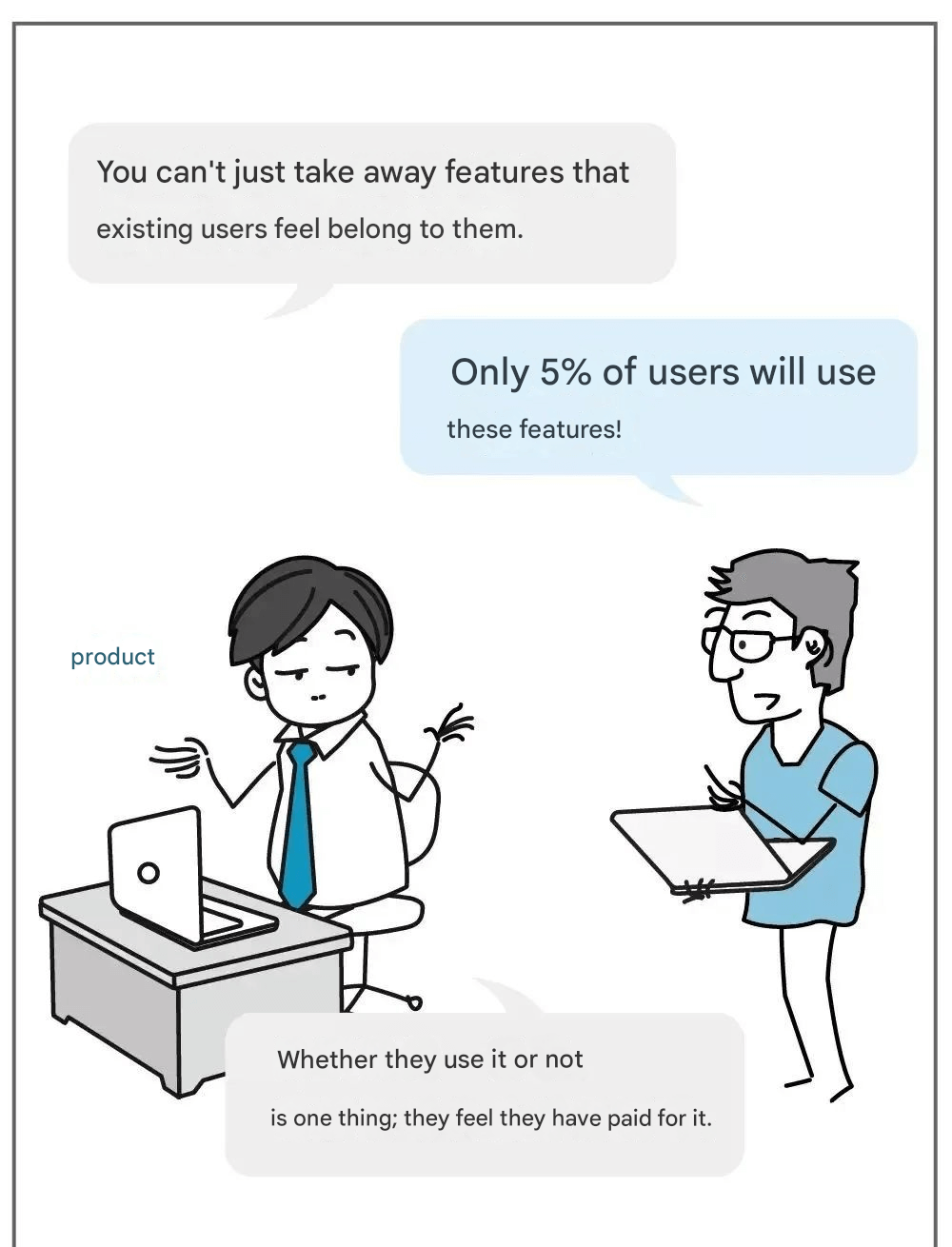Over the past couple of days, there’s been a niche piece of news—I'm not sure if you've heard of it.
The general idea is:
The Browser Company has announced that it is developing a brand-new AI browser, Dia, which is set to launch in early 2025. The Dia browser plans to leverage AI tools to simplify our everyday tasks on the internet and provide users with a more intelligent browsing experience.
Reading this, you might feel a little confused because, though brief, it contains a lot of information.
For example: Who is The Browser Company? What is the Dia browser? And why hasn’t it launched yet, but is already generating buzz?
1
Don’t rush, let’s break it down. The Browser Company is the name of an internet browser company that focuses on browser development. Its founder and CEO is Josh Miller.
The company’s name stems from Miller's reflections after the 2016 U.S. presidential election, during which he realized that the impact of the tech industry on society needed to be reconsidered.
Miller’s credentials are quite impressive.
He served as the White House Product Director from 2015 to 2017, then moved to the renowned venture capital firm Thrive Capital. In 2019, he decided to dive into entrepreneurship and focus on browser development.
He believes that in order to truly change the way society uses technology, one must create a platform or “operating system.” With this vision, he embarked on the journey of creating a new browser.
Within two years, the company launched its first product: the Arc browser. What makes this browser different?
Let me share my experience: when you open the Arc browser, you’ll notice some unique design elements and fresh ideas. At first, it might feel a little unfamiliar, and you’ll need some time to adjust.
It is not a traditional browser in the usual sense. Most browsers are used to display webpages, with tabs, address bars, bookmarks, and possibly extensions. Arc, however, functions more like a “web operating system.”
What is an operating system, for example:
Siri and Apple Pay work by figuring out how different apps can seamlessly interact on an iPhone. Similarly, AutoGLM explores how to control your phone like a human. These are all tasks of an operating system.
Arc designs tabs and bookmarks like an app launcher. It treats web tools as modular components that can be “dragged” and “combined” anytime. By simply clicking on a tab, you can open your most-used websites and tools.
This process is as simple as opening an app on your phone, and you can freely adjust and combine these modules to create a personalized experience.
In other words, Arc treats anything on the internet as a detachable and reconfigurable system.
To put it simply, it's like when you're watching short videos and come across something you like—you can save it, re-edit it, and create your own version.

Image caption: Josh Miller's first browser, Arc, main interface
So, why does Josh Miller want to make a different browser?
This ties back to his philosophy.
He believes that it is almost impossible to challenge industry giants through traditional means. To succeed, you need to find a unique path and create a new category.
This positioning is something big companies, like Google, wouldn’t replicate. Google has around 3.3 billion daily active users, and its Chrome browser runs very smoothly. It’s a “quiet” browser that doesn’t disturb users’ habits, and most people like it.
In fact, it’s fair to say that even Google itself would struggle to surpass Chrome.
However, companies like Google are unlikely to risk changing such a successful product because doing so could bring risks, affect revenue, and make users uncomfortable.
The original idea behind Arc was to target a small group of users who spend long hours on their computers. These people use browsers frequently every day, are dissatisfied with the current browsing methods, but can’t pinpoint exactly what the problem is. They’re longing for a new experience.
And so, Arc was born—to offer these users a different choice.
2
Tim Cook once said in a public speech: “If you’re not paying for the product, you are the product.” This statement directly highlights an important question: How does a product make money?
Josh Miller believes there are four ways for Arc to generate revenue:
Charge for premium features, membership fees.
Sell the default search engine position to Google, earning advertising revenue.
Offer a free version with premium features for users who upgrade.
Focus on team collaboration, monetizing from enterprise customers like Notion.
However, Arc places a high emphasis on privacy and wants to avoid Google Search, so the second option is unlikely. They are more inclined towards the third and fourth options. Josh has also publicly stated that the future of the internet is social and collaborative.
But the question remains: Can a collaboration-focused browser attract corporate clients?
Currently, products like Perplexity are already offering similar features, such as adding collaborative spaces after the search function. However, these features are still not mature enough, making it difficult to convince large companies to adopt them.
In my opinion, Arc will likely try the first approach: launch a simple paid model with a 30-day free trial version for users to experience its unique features, then offer deeper customization options for paid users. Corporate clients might even purchase discounted licenses.
In fact, Arc's strategy seems to follow this pattern.
They attract users first and will gradually consider monetization. But to this day, Arc has been free for a year. However, the idealism doesn’t always align with reality, leading to a situation where:
Arc’s powerful features come with a high learning curve for average users, slowing its growth.
With slow growth and no revenue source, it has to rely on burning investor money, making the model hard to sustain.
As a result, Arc recently announced that development has stopped. The official reason is that its complexity and uniqueness made it difficult for users to get started, preventing it from attracting more users.
However, I believe that Arc’s failure doesn’t mean its philosophy is wrong.
Josh Miller has said:
Large language models and AI technologies (such as Transformers) have profoundly changed the way websites and searches operate, but the browser field has been largely unaffected. What Arc aims to do is integrate web browsing, search, and creation into one, creating an entirely new category.
Arc’s positioning cannot simply be seen as a content generation tool.
If a product merely improves the user experience, it hasn’t really changed the core direction. Arc’s goal is to redefine the role of browsers on the internet, upgrading it to a “system.”
Though Arc failed after a year, it didn’t follow the old model.
In the age of AI, we do need a smarter, more integrated browser to adapt to our current way of life. If you’ve experienced Arc, you’d feel that it truly functions like an internet assistant, an all-in-one entry point that handles everything.
3
If you’ve looked into the history of browsers, you might gain a new understanding of what’s needed today.
The first browser was called Mosaic, developed by Marc Andreessen and his team at the University of Illinois. What made this browser remarkable?
It was the first to display both images and text on a webpage, enabling us to interact with graphical websites. Once this "gateway" opened, websites started to pop up. Then came Netscape and Microsoft. In 1996, Netscape became the most popular browser, capturing 80% of the market share.
However, Microsoft recognized the importance of controlling the internet, so they developed Internet Explorer 1.0. Prior to this, the default browser on Windows was simply an icon labeled "The Internet."
By 1998, the clever bundling of Internet Explorer with Windows PCs allowed it to capture more than 65% of the market share. In the 1990s, Microsoft won the first battle in the browser war.
By 2003, Internet Explorer's market share had reached 95%.
At this point, Firefox and Safari entered the competition. Firefox quickly rose to second place with a market share of about 5%, while Safari had only 1%. Although IE remained dominant, the browser war was heating up.
In the early 2000s, Safari and Firefox gradually weakened IE’s market share. Meanwhile, Google was building a powerful search business, with its search products becoming the navigation layer of the internet.
In October 2000, Google earned its first ad revenue and soon started making huge profits. Search and web navigation became their cash cow. When you have a cash cow, it makes sense to nurture it, right? So, Google began to think about how to provide more data input.
They found an obvious answer: acquire more data by gathering information beyond search. In 2004, Google launched its own browser, and new browser stories started to emerge domestically.
For example:
In 2008, 360 launched its own browser, focusing on security.
In 2011, Tencent launched QQ Browser, leveraging the QQ user base.
There were also browsers like Sogou Browser and Cheetah Browser.
You might be wondering, what about Baidu? From the early days, Baidu was not a complete browser.
It was primarily a search tool for quickly accessing and providing services. For example, you could search for news or videos. It wasn’t until 2011 that Baidu launched a full browser with essential features like tab management, download tools, and privacy modes.
Looking back now, the competition between PC and mobile browsers has already ended. Those who made money from ads are now rich, and new entrants can’t change the established market positions.
However, the emergence of AI presents a fundamental opportunity for restructuring. Why is that? The browser architecture is divided into three layers:
Control/Basic Layer (Chrome, Edge)
Content Layer
Navigation Layer
The Basic Layer is the foundational platform through which we interact with the internet. It represents the software used to browse the web, such as Chrome, Firefox, or Edge. The Content Layer is the website itself, which holds all the online content we access, including text, images, videos, etc.
The Navigation Layer consists of search engines and navigation tools, which help us find resources in the content layer. It is responsible for guiding and connecting users, like using Google or Bing search engines, where we input keywords and quickly find the information we want.
These three layers form the foundation of our daily internet experience.
4
With the addition of AI, the Navigation Layer is no longer just a search engine. It can now understand our questions, provide direct answers, and even predict what we want, saving us the trouble of searching.
In the Control Layer, AI also makes browsers smarter. It can adjust the interface based on our habits and automatically organize tabs. In the Content Layer, it comes down to who can attract content creators and provide them with useful tools to create good content and form workflows.
So, by understanding these layers, it becomes clear what AI is really changing.
AI is making the Basic Layer and Navigation Layer more advanced. The company that can innovate through technology, turning capabilities into modules, and then flexibly combine them based on user needs, will be able to improve efficiency and make browsers smarter.
At this point, you might say: "Efficiency is a vague term. How exactly can efficiency be improved?"
Let me give an example:
Let’s say you want to buy something. Typically, you’d first go to video websites to check reviews, then visit platforms like shopping review sites to see evaluations, compare prices, and finally decide what to buy. This process is slow and frustrating.
But what if a browser could integrate each step of this process—every webpage you visit—into one seamless flow, providing you with a purchase suggestion at the end? For example, showing you the best cost-effective option with a direct purchase link. Wouldn’t that be both time-saving and convenient?
This is where AI changes the browser.
Don’t think it’s impossible. Tools like Kimi Chat can already search for product information and offer recommendations. Therefore, such functionality could easily be further implemented through a browser.
Now, looking back at the initial information we mentioned, Josh Miller, the CEO of The Browser Company, said in an interview: Dia, using AI technology, is not just an ordinary browser—it aims to bring artificial intelligence to every corner of the web.

Image caption: Josh Miller’s thoughts on the next-generation browser (screenshot from Dia official website)
They even made a promotional video. The video features some prototype functions, such as intelligent writing assistants, automation, and natural language commands. Josh Miller believes AI is not just an app or a button, but will become a new environment built into web browsers.
This idea is quite clear: Dia wants to use intelligent features to make browsing faster and better. It may include automatic organization of information, smart search, and recommending things you might be interested in.
Compared to the existing Arc Browser, Dia places more emphasis on AI. Arc has gained popularity due to its unique interface and flexible operation, but Dia takes it further. By analyzing your behaviors and needs, Dia will offer more accurate and personalized services.
This could include tasks like writing, creating, following your favorite creators, browsing websites, or subscribing to videos… Josh Miller will undoubtedly learn a lot from the experience with Arc.
Conclusion
Will browsers become like operating systems?
What will the next-generation browser look like? This is definitely something worth paying attention to.







